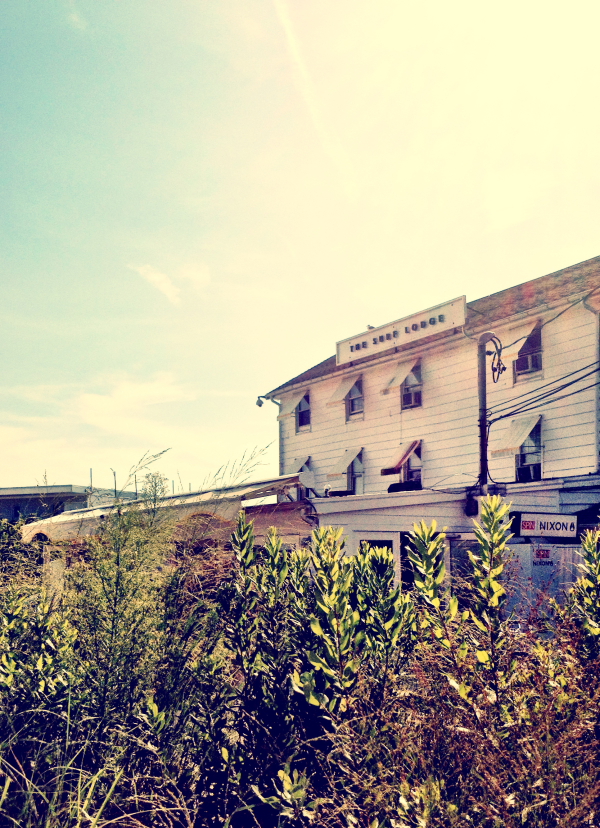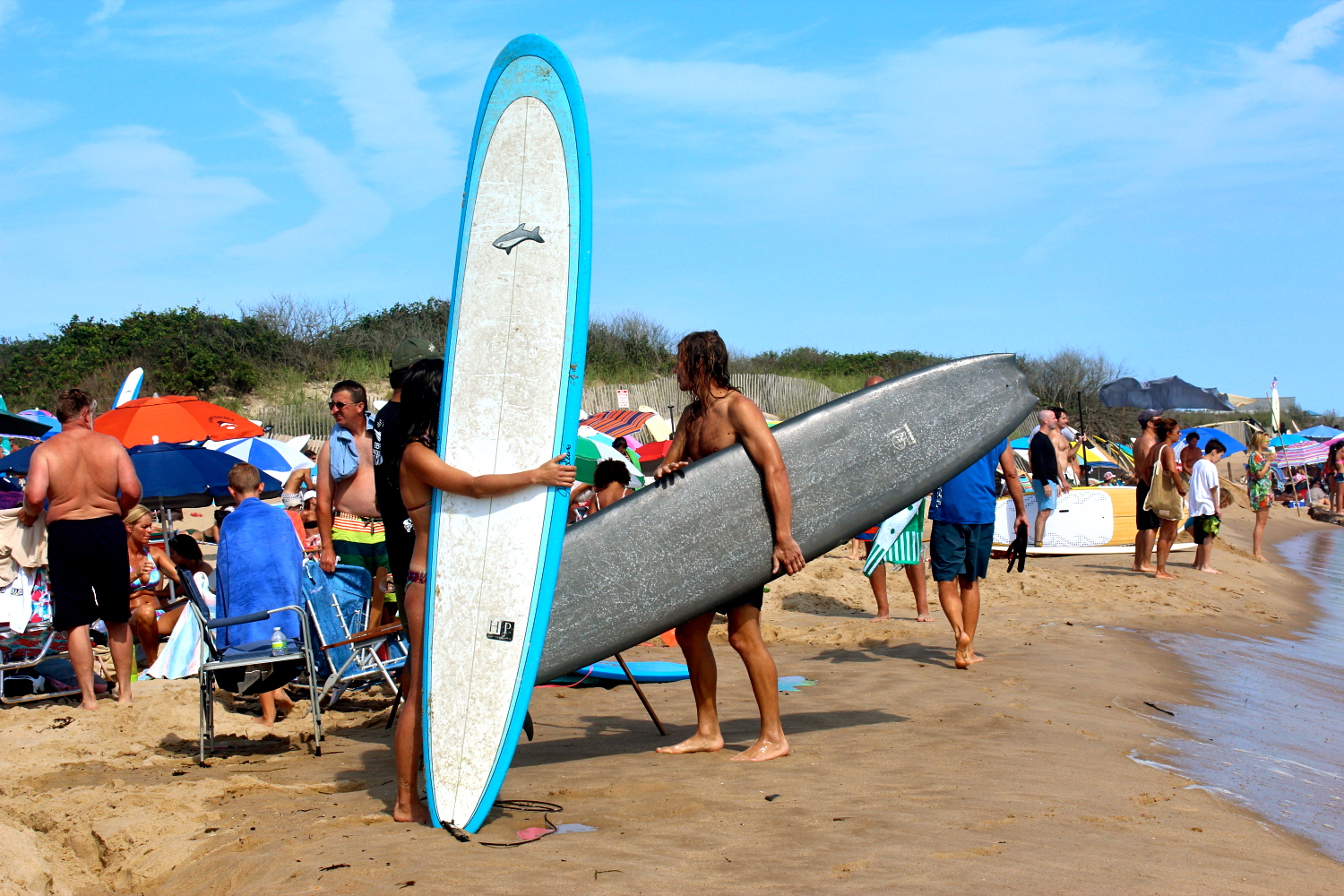Montauk's Surf Lodge, photographed by Kirsten Chilstrom
The New York Times declared it: "Montauk Feels the Effects of Too Many Hipsters." It was a bold statement, in Jim Rutenberg's Style Section article, titled "Montauk's Hipster Fatigue," which went live on August 3. In his piece, Rutenberg begins by discussing a sign, seen throughout Montauk, of a fedora with a slash through it. Below it, the observer finds the ominous caption, "Save Montauk." The hat, Rutenberg says, "represents your basic hipster." He goes on to describe a hipster as someone with "artisanal tattoos; a bespoke, frontiersman beard; and, yes, a fedora perched atop the head." These superficial qualities are accompanied, he continues, by an attitude of "I'm richer than you, I'm hipper than you and, gosh darn it, some things are going to change around here."
This past Saturday, I hopped into a friend's car and headed east to see for myself if East Hampton's rural eastern neighbor really had been invaded by this "hipster" subculture, which is so often personified by a pair of skinny jeans, an ironic getup, and, as The New York Times noted -- a fedora.
I drove into town, armed with a current list of popular places to visit in Montauk: Ditch Plains Beach, Surf Lodge, and Ruschmeyer's, to name a few. After enjoying some fresh seafood at a small roadside café, aptly named "Clam Bar," I headed down to the water, where surfers, families, and laid-back locals had planted themselves along the surf amidst a sea of umbrellas. Of all the places to spend an afternoon, this is undoubtedly the best and least pretentious option, as the beach is nestled far from the main road in a low-slung neighborhood of quaint beach bungalows, shielded from an onslaught of townies looking for a place to fend off their urban translucency. Overall, if I'm honest, it was difficult to differentiate a local Montauker from what I consider a hipster, as everyone wore basically the same uniform of a swimsuit, a golden tan, and a broad smile that can only be attained while slouched in a canvas chair, bathed in the summer sun.
After a couple hours wandering along the surf, I remained unsuccessful at finding any signs of a hipster invasion. I decided to continue my search downtown on Montauk Village's unpresumptuous commercial square. There, my friend and I encountered our first indication of decidedly un-Montauk cultural upheaval. Louder than the roar of the ocean, which couldn't have been more than 300 yards away, a beat throbbed through the speakers of the Sloppy Tuna, a disturbingly popular beachfront bar. Though I tried not to listen, I believe it was some incarnation of the Black Eyed Peas, circa several-years-ago, or some other tragic Top 40 hit which had been long ago died a slow death in the spray-tanned nightclubs of Manhattan's Meatpacking District. Looking up from the street at the bar's balcony, my eyes absorbed a sea of bodies, clad in khaki, critter-embroidered shorts; across the scene, a boatload of designer sunglasses, shielding from the noon sun the eager eyes of over-bronzed, under-dressed, cocktail-sipping twenty-somethings. They were all there to have a drink and mingle (loudly) before retreating to some generic share house, à la MTV's The Real World, to continue pre-gaming for a night of raucous exuberance.
Ditch Plains Beach, photographed by Kirsten Chilstrom
Eager to escape, I headed inland to Surf Lodge, where I took in a sound check for Nite Jewel, an L.A.-based band scheduled to perform later that evening. The lead singer and her bandmates were dressed mostly in black, American-Apparel-esque ensembles, and toed the line of what could be considered "hipster." Alas, a visiting West Coast, possibly-hipster band doesn't exactly meet the criteria of "invasion" cited by the Times. The music was soothing and the atmosphere was relaxing next to Fort Pond, and after a beer and a few songs, I carried on with my search. At Ruschmeyer's, which sits on the opposite side of the Pond, I encountered an outdoor bar area with ping-pong and picnic tables set on a bed of sand. I met a lively mixed group from Italy and the U.K., tried my hand at limbo, and downed more than one cup of rum punch. It was charming, fun, and everyone was amused by the fact that I lived in Brooklyn (only one in the group had actually stepped foot in Williamsburg, the oft-cited Capitol of Hipsterdom). After dinner under the stars, surrounded by lovely, pleasant company, I found myself wondering, "Where are all the hipsters?"
While it still has no clear definition, Merriam-Webster lists a hipster as "a person who is unusually aware of and interested in new and unconventional patterns (as in jazz or fashion)." A similar point of view has been shared among critics, and that is that hipsters have always sought to be ahead of the masses. In 2010, the New York Times published an article by Mark Greif, "The Hipster in the Mirror," in which he stated that, "all hipsters play at being the inventors or first adopters of novelties: pride comes from knowing and deciding, what's cool in advance of the rest of the world." He reiterated this thought in a similar piece he wrote for New York magazine that same year: "The hipster is a savant at picking up the tiny changes of rapidly cycling consumer distinction." If Greif's stance holds any truth in what it means to be hipster, then the crowd that was mingling at Sloppy Tuna last weekend is clearly late to the party, and therefore, doesn't fit the definition of the word "hipster." Historically known to be hippies, rebels, and artists, the term "hipster" has only recently begun to find itself twined, intentionally or not, with that most non-hip, non-rebellious, and non-artistic of demographics -- the Yuppie.
According to the same dictionary, a yuppie is "a young college-educated adult who is employed in a well-paying profession and who lives and works in or near a large city." It's hard to stay on the cutting edge of fashion, art, and innovation when you're busy building a stock portfolio and ironing pleats into your 42 pairs of Brooks Brothers slacks. Only when they've amassed enough money to feel invincible do these Yupsters suddenly realize that they've wasted their most creative and free-spirited years in a cubicle, and they covet the unique joie-de-vivre so often found in secluded, artist-filled locales such as Montauk.
Montauk has been unconventionally cool for generations. Its recent increase in popularity among urbanites is not necessarily a great shock to anyone observing from the outside. It's been more than three decades since Andy Warhol starred in Cocaine Cowboys, which was filmed at his Montauk house. The Rolling Stones, Jacqueline Kennedy-Onassis, Francis Bacon and Julian Schnabel have all left their mark on the area; and in the past decade, it has become the home-away-from-home for such names as Ralph Lauren, Bruce Weber, and Mickey Drexler. In 2005, designer Cynthia Rowley married Bill Powers at Peter Beard's end-of-island estate. With Montauk so heavily weighted with big names and bigger reputations, I found myself wondering why it took so long for its mainstream popularity to take off in the first place.
Montauk is not alone -- neighborhoods and towns throughout the greater New York area have routinely felt the effects of artsy gentrification for many years. Manhattan is filled with quirky neighborhoods and enclaves that have been saved from the brink of urban death by the enigmatic spell cast by the movers, shakers, and artists personifying the aforementioned definition of "hipster." From the West Village to the Lower East Side. From SoHo to Hell's Kitchen. From the days of Bob Dylan hanging out in Greenwich Village to the Alphabet City escapades portrayed in Rent, the flow of humanity has remained the same: artists infuse life into a neighborhood with low rent; hipsters join the early settlers to enjoy that low rent and to get a taste of the emerging counter-cultural artistic movement; once the neighborhood has achieved just the right level of artistry, vibrancy, and safety, yuppies decide they want a piece of the creative pie, moving into renovated lofts, pushing rent higher, and contributing little to the innovative spirit which attracted them to the neighborhood in the first place. Eventually, the shadowy masses: tourists, suburbanites, and commercial enterprises aimed at parting those masses from their many dollars, begin to strip away from the neighborhood all that had once made it special. Duane Reade, 7-11, Starbucks, and host of other dreary chains seal the deal. Before you know it, most of the artists and pioneers have fled and those brave enough to hang on dodge strollers and plow through walls of taxi yellow M&Ms World bags on their walk to the subway or bodega. Locals grow angry and protest the change. Artists and hipsters fume at being forced to follow their rental budgets to some new and unknown neighborhood further from the city's center. And the yuppies are left standing on the Louboutins, sipping $20 cocktails, and wondering why the neighborhood isn't fun any more.
So is Montauk really being invaded by hipsters? That is the question this writer is asking. I asked one particularly loyal Montauk resident her thoughts on the matter. Her email response summed it up rather eloquently: "What is a hipster? I do notice that there are a lot of people who act like they are hip and bring rudeness and bad energy to Montauk, most of them 50 and under... souless fools that I try to avoid at all costs. Totally uncultured bunch; all show and no go." I think Merriam and Webster would agree: it doesn't sound like the problem comes from hipsters.
There is a pervasive lack of understanding of "hipster," both as a noun and an adjective. The New York Times used the word more than 250 times in 2010 alone, with almost as many connotative definitions. Is a hipster a person who lives on the edge, checking the pulse for what is next, following the latest in fashion and music wherever it is to be found, all the while clutching a PBR and a Marlboro? It could be argued that a hipster is merely a follower of movements: facelessly chasing whatever trends are elevated by the great invisible Pop Culture God-in the-sky. Regardless, I feel it is unfair and unwise to blame Hipsters for the cultural hardships befalling enclaves like Montauk. There is no denying that artists, musicians, creative types of all kinds, along with the hipsters they attract, have moved these places forward, sparking trends, and breathing new life into anything and any place they deem worthy. When the term "hipster" is used derogatorily to isolate a group of people who are, in fact, but a piece of the greater gentrifying puzzle, it sends a terrible message. Because in all actuality, the qualities and passions of the hipster make the places what they are. They're not the problem, and they shouldn't be treated as such.
Contributions and editing by Keith Taillon @keithimus.
For more information on what it means to be hipster, see the following:
"Why the hipster must die," by Christian Lorentzen.
"What Was the Hipster," by Mark Greif.
"Everything Old Is Hip Again," by Philip Corbett.
"It's Hip to Be a Young, Creative Urbanite!" by J. David Goodman.

